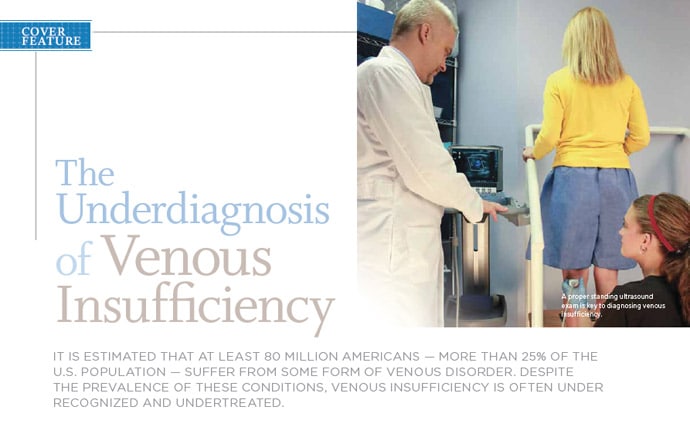

VENOUS INSUFFICIENCY IS the underlying problem that leads to varicose veins and much more. It occurs when faulty valves allow the blood in the veins to flow backwards and pool in the lower half of the body. The increased pressure from the pooled blood leads to additional veins becoming elongated, dilated and gnarled (or varicose). In turn, these veins fail, leading to greater compromise of proper blood flow back to the heart. Under the force of gravity, the increasing pool of uncirculating venous blood leads to venous hypertension. Venous hypertension leads to inflammation and congestion in the tissue of the legs and is responsible for the symptoms of venous insufficiency, which can include edema, pain, aching skin discoloration, leg cramping, leg fatigue and restlessness.
“Untreated venous issues can lead to a multitude of serious health problems, including variceal bleeding, venous ulcers and blood clots, also known as deep venous thrombosis,” says Thomas Wright, M.D., FACP, RVT, Medical Director of Laser Lipo & Vein Center in St. Louis, MO. “It’s important to dispel the myth that venous insufficiency is just a cosmetic issue. Leaving venous issues untreated can eventually lead to much larger problems.”
Venous insufficiency can be the underlying cause for a plethora of other conditions, including lower extremity cellulitis, restless legs syndrome and leg cramps. According to Dr. Wright, when patients present with venous insufficiency symptoms, physicians often only check some of the obvious explanations and do not delve deeper to look for the possibility of venous reflux as an underlying cause.
For example, patients with venous insufficiency may experience leg cramps. When patients report this symptom, physicians often check potassium and calcium levels, but they seldom refer patients for a venous Doppler exam, even in patients’ symptoms are worse after standing of if they have physical signs of venous insufficiency, such as spider veins or skin changes. “There’s a large percentage of people walking around with venous problems who aren’t getting the evaluation or treatment they need,” says Dr. Wright.
Venous Insufficiency, Venous Stasis Dermatitis and Cellulitis
Patients with venous insufficiency often develop a rash on the legs called stasis dermatitis. The increased venous pressure in the legs is transmitted to the capillaries. The pressure leads to the release of red blood cells and other inflammatory substances that produce a reddish discoloration of the skin. This rash responds best to lubrication or a mild steroid cream and compression stockings or wraps to counterbalance the venous hypertension. Ultimately, the best treatment is the correction of the underlying cause of venous insufficiency.
Additionally, because of the underlying inflammation in the skin, patients with venous insufficiency are also prone to developing cellulitis. Cellulitis is a potentially serious bacterial skin infection – most commonly occurring in the skin on the lower legs – that can affect both the skin’s surface and its underlying tissue. It is often difficult to know for sure whether the reddened, tender and swollen leg is caused by venous insufficiency alone or if there is a bacterial infection as well. Antibiotics should be used to treat the cellulitis; however, if the underlying cause is venous insufficiency, cellulitis will likely return if the root cause is not treated.
